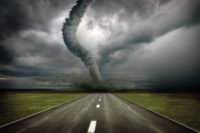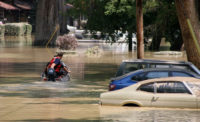Stronger Building Codes Could Have Saved More in Joplin Tornado

Stronger building codes, more storm shelters and improved emergency communication systems could have significantly reduced the death toll and the costs of rebuilding from the 2011 Joplin tornado.
The National Institute of Standards and Technology, which is part of the U.S. Commerce Department, released its 492-page draft report in Joplin at a Missouri Southern State University news conference. The agency called the study the first to take a systematic look at how communities across the country can better prepare for tornadoes — in essence, how to prevent another Joplin-scale disaster.
"The overarching conclusion of our two-year study is that death and destruction from tornadoes can be reduced," said Eric Letvin, the institute's director of disaster and failure studies.
"Our scientific understanding of tornadoes and their effects has matured substantially," he added. "It's time to begin developing and implementing nationally accepted standards and codes that directly address tornado hazards."
The May 2011 Joplin tornado killed 161 people and destroyed thousands of buildings, including homes, churches, businesses big and small, and one of the city's two hospitals. The study found that all but 26 of the deaths came from building collapses. It cited "confusion about or distrust" of emergency storm warnings and a "lack of awareness" of the tornado's approach.
The study documents 47 specific findings and offers 16 recommendations. But institute officials emphasized that most of the power to make such changes rests with state and local governments, and private businesses.
In Joplin, elected leaders have agreed to require all post-tornado construction to use hurricane-clips on every rafter and truss. An American Society of Civil Engineers study released in June found that more than 83 percent of the structural damage was caused by winds of up to 135 mph, which is the equivalent maximum wind speed of an EF-2 tornado.
And while the National Weather Service classified the Joplin tornado as an EF-5, with peak winds of more than 200 mph, both recent studies conclude that much of the damage could have been avoided with sturdier construction.
"The buildings in Joplin performed as expected," Letvin said. "They were not designed to withstand tornado winds. And not surprisingly, they failed."
The city also lacked community storm shelters for those in harm's way, the report noted. Joplin has since made such structures a hallmark of its rebuilding efforts, with plans to build reinforced safe rooms at each of its public schools. The city has also received dozens of storm shelters that were used by the Federal Emergency Management Agency at temporary housing sites that have since been closed.
The report urges policymakers and construction industry leaders to engage in more uniform oversight of tornadoes akin to preventative efforts taken with other natural disasters.
"Current U.S. model building codes include requirements to protect against many different types of hazards, including hurricanes, earthquakes and floods," Letvin said. "They do not include requirements to protect against tornado hazards, which include extreme wind speeds and impacts from wind debris."
Looking for a reprint of this article?
From high-res PDFs to custom plaques, order your copy today!









